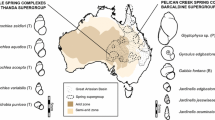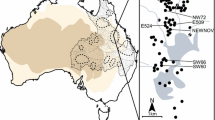Abstract
Niche breadth has fundamental ecological implications. Specialists with a narrow niche space are able to survive under specific conditions only, making them potentially sensitive to effects of environmental change. We here investigate (1) the factors restricting the specialized spring snail Bythinella dunkeri to its specific habitat, and (2) its capacity for plasticity to respond to changing environmental conditions, based on a combination of field work and laboratory experiments. By comparing occupied and unoccupied sites, we revealed that snail presence was most strongly affected by distance to the crop-out, water depth, pH value, and redox potential. In contrast, spring temperatures did not affect the occurrence of this ‘stenothermic’ snail, and laboratory experiments documented a high tolerance toward both high and fluctuating temperatures. However, B. dunkeri was found to be very sensitive to desiccation, such that changes in precipitation regimes may easily harm populations. The species investigated here may therefore indeed be sensitive to environmental change, but not because of limited thermal tolerance which initially seemed to be the most obvious reason.



Similar content being viewed by others
References
Battin, T. J., L. A. Kaplan, J. Denis Newbold & C. M. E. Hansen, 2003. Contributions of microbial biofilms to ecosystem processes in stream mesocosms. Nature 426: 439–442.
Benke, M., M. Brändle, C. Albrecht & T. Wilke, 2009. Pleistocene phylogeography and phylogenetic concordance in cold-adapted spring snails (Bythinella spp.). Molecular Ecology 18: 890–903.
Benke, M., M. Brändle, C. Albrecht & T. Wilke, 2011. Patterns of freshwater biodiversity in Europe: lessons from the spring snail genus Bythinella. Journal of Biogeography 38: 2021–2032.
Boag, D. A., 1986. Dispersal in pond snails: potential role of waterfowl. Canadian Journal of Zoology 64: 904–909.
Bradshaw, W. E. & C. M. Holzapfel, 2006. Evolutionary response to rapid climate change. Science 312: 1477–1478.
Brändle, M., I. Westermann & R. Brandl, 2005. Gene flow between populations of two invertebrates in springs. Freshwater Biology 50: 1–9.
Brown, J. H., 1984. On the relationship between abundance and distribution of species. American Naturalist 124: 255–279.
Cantonati, M., R. Gerecke & E. Bertuzzi, 2006. Springs of the Alps–sensitive ecosystems to environmental change: from biodiversity assessments to long-term studies. Hydrobiologia 562: 59–96.
Clenaghan, C., P. S. Giller, J. O’halloran & R. Hernan, 1998. Stream macroinvertebrate communities in a conifer-afforested catchment in Ireland: relationships to physico-chemical and biotic factors. Freshwater Biology 40: 175–193.
Cushman, S. A., 2006. Effects of habitat loss and fragmentation on amphibians: a review and prospectus. Biological conservation 128: 231–240.
Delicado, D., A. Machordom & M. A. Ramos, 2014. Vicariant versus dispersal processes in the settlement of Pseudamnicola (Caenogastropoda, Hydrobiidae) in the Mediterranean Balearic Islands. Zoological Journal of the Linnean Society 171: 38–71.
Di Sabatino, A., B. Cicolani & R. Gerecke, 2003. Biodiversity and distribution of water mites (Acari, Hydrachnidia) in spring habitats. Freshwater Biology 48: 2163–2173.
Dillon, R. T., 2000. The Ecology of Freshwater Molluscs. Cambridge University Press, Cambridge.
Dussart, G. B. J., 1979. Life cycles and distribution of the aquatic gastropod molluscs Bithynia tentaculata (L.), Gyraulus albus (Muller), Planorbis planorbis (L.) and Lymnaea peregra (Muller) in relation to water chemistry. Hydrobiologia 67: 223–239.
Eckhardt, K. & U. Ulbrich, 2003. Potential impacts of climate change on groundwater recharge and streamflow in a central European low mountain range. Journal of Hydrology 284: 244–252.
Falniowski, A., 1987. Hydrobioidea of Poland (Prosobranchia: Gastropoda). Folia Malacol 1: 1–122.
Falniowski, A. & M. Szarowska, 2011. Radiation and Phylogeography in a Spring Snail Bythinella (Mollusca: Gastropoda: Rissooidea) in Continental Greece. Annales Zoologici Fennici 48: 67–90.
Falniowski, A., M. Szarowska & I. Sirbu, 2009. Bythinella Moquin-Tandon, 1856 (Gastropoda: Rissooidea: Bythinellidae) in Romania: species richness in a glacial refugium. Journal of Natural History 43: 2955–2973.
Figuerola, J. & A. J. Green, 2002. Dispersal of aquatic organisms by waterbirds: a review of past research and priorities for future studies. Freshwater biology 47: 483–494.
Fox, L. R. & P. A. Morrow, 1981. Specialization: species property or local phenomenon. Science 211: 887–893.
Gaston, K. J., T. M. Blackburn & J. H. Lawton, 1997. Interspecific abundance-range size relationships: an appraisal of mechanisms. Journal of Animal Ecology 66: 579–601.
Haase, M., 2003. Clinal variation in shell morphology of the freshwater gastropod Potamopyrgus antipodarum along two-hill country streams in New Zealand. Journal of the Royal Society of New Zealand 33: 549–560.
Haase, M., M. D. Naser & T. Wilke, 2010. Ecrobia grimmi in brackish Lake Sawa, Iraq: indirect evidence for long-distance dispersal of hydrobiid gastropods (Caenogastropoda: Rissooidea) by birds. Journal of Molluscan Studies 76: 101–105.
Havel, J. E., L. A. Bruckerhoff, M. A. Funkhouser & A. R. Gemberling, 2014. Resistance to desiccation in aquatic invasive snails and implications for their overland dispersal. Hydrobiologia 741: 89–100.
Hoffsten, P.-O. & B. Malmqvist, 2000. The macroinvertebrate fauna and hydrogeology of springs in central Sweden. Hydrobiologia 436: 91–104.
Hunter, R. D., 1990. Effects of low pH and low calcium concentration on the pulmonate snail Planorbella trivolvis: a laboratory study. Canadian Journal of Zoology 68: 1578–1583.
Illies, J., 1978. Limnofauna europaea. Gustav Fischer Verlag, Stuttgart.
Johnson, C. N., 1998. Species extinction and the relationship between distribution and abundance. Nature 394: 272–274.
Jungbluth, J. H., 1973. Zur Verbreitung und Ökologie von Bythinella dunkeri und compressa (Frauenfeld 1856). Verhandlungen des Internationalen Verein Limnologie Part 3: 1576–1585.
Jungbluth, J. H. & D. Knorre, 2009. Rote Liste der Binnenmollusken [Schnecken (Gastropoda) und Muscheln (Bivalvia)] in Deutschland: - 6. Fassung. Mitteillungen der deutschen malakozoologischen Gesellschaft 81: 1–28.
Lindegaard, C., K. P. Brodersen, P. Wiberg-Larsen & J. Skriver, 1998. Multivariate analyses of macrofaunal communities in Danish springs and springbrooks. In Botosaneanu, L. (ed.), Studies in Crenobiology: The Biology of Springs and Springbrooks. Backhuys Publishers, Leiden: 201–210.
Lock, M. A. & T. B. Reynoldson, 1976. The role of interspecific competition in the distribution of two stream dwelling triclads, Crenobia alpina (Dana) and Polycelis felina (Dalyell), in North Wales. The Journal of Animal Ecology 45: 581–592.
McCabe, D. J., 1998. Biological communities in springbrooks. In Botosaneanu, L. (ed.), Studies in Crenobiology. The Biology of Springs and Springbrooks. Backhuys Publishers, Leiden: 221–228.
McDonald, D. L., T. H. Bonner, E. L. Oborny & T. M. Brandt, 2007. Effects of fluctuating temperatures and gill parasites on reproduction of the fountain darter, Etheostoma fonticola. Journal of Freshwater Ecology 22: 311–318.
Muniz, I. P., 1991. Freshwater acidification: its effects on species and communities of freshwater microbes, plants and animals. Proceedings of the Royal Society of Edinburgh 97: 227–254.
Oswald, D., A. Kureck & D. Neumann, 1991. Populations dynamik, Temperaturtoleranz und Ernährung der Quellschnecke Bythinella dunkeri (Frauenfeld 1856). Zoologische Jahrbücher. Abteilung für Systematik, Ökologie und Geographie der Tiere 118: 65–78.
Parmesan, C. & G. Yohe, 2003. A globally coherent fingerprint of climate change impacts across natural systems. Nature 421: 37–42.
Ponder, W. F. & D. J. Colgan, 2002. What makes a narrow-range taxon? Insights from Australian freshwater snails. Invertebrate Systematics 16: 571–582.
Rees, W. J., 1965. The aerial dispersal of Mollusca. Malacological Society of London 36: 269–282.
Reiss, M., 2011. Substratpräferenz und Mikrohabitat-Fauna-Beziehung im Eukrenal von Quellgewässern. Dissertation, Philipps-Universität, Marburg.
Ricklefs, R. E., 2010. Evolutionary diversification, coevolution between populations and their antagonists, and the filling of niche space. Proceedings of the National Academy of Sciences of the United States of America 107: 1265–1272.
Sala, O. E., F. S. Chapin, J. J. Armesto, E. Berlow, J. Bloomfield, R. Dirzo, E. Huber-Sanwald, L. F. Huenneke, R. B. Jackson & A. Kinzig, 2000. Global biodiversity scenarios for the year 2100. Science 287: 1770–1774.
Schindler, D. W., 1988. Effects of acid rain on freshwater ecosystems. Science 239: 149–157.
Slatyer, R. A., M. Hirst & J. P. Sexton, 2013. Niche breadth predicts geographical range size: a general ecological pattern. Ecology letters 16: 1104–1114.
Spyra, A., 2010. Environmental factors influencing the occurrence of freshwater snails in woodland water bodies. Biologia 65: 697–703.
Steingötter, K., 2005. Geologie von Rheinland-Pfalz. E. Schweizerbart’sche Verlagsbuchhandlung (Nägele u. Obermille), Stuttgart.
Sturm, R., 2005. Modelling optimum ranges of selected environmental variables for habitats colonized by the spring snail Bythinella austriaca (v. Frauenfeld, 1857)(Gastropoda, Prosobranchia). Malak. Abh 23: 67–76.
Swihart, R. K., T. M. Gehring, M. B. Kolozsvary & T. E. Nupp, 2002. Responses of `resistant´ vertebrates to habitat loss and fragmentation: the importance of niche breadth and range boundaries. Diversity and Distributions 9: 1–18.
Szarowska, M., 1996. The egg capsules of Bythinella austriaca (Frauenfeld, 1856) with observations on the veliger and embryonic shell. Journal of Molluscan Studies 62: 546–549.
Szarowska, M., 2000. Environmental threats and stability of Bythinella populations in SouthPoland (Gastropoda: Prosobranchia: Hydrobioidea). Malakol Ab Staat Mus Tier Dresden 20: 93–98.
Thomas, C. D., A. Cameron, R. E. Green, M. Bakkenes, L. J. Beaumont, Y. C. Collingham, B. F. N. Erasmus, M. F. De Siqueira, A. Grainger & L. Hannah, 2004. Extinction risk from climate change. Nature 427: 145–148.
Thuiller, W., S. Lavorel & M. B. Araujo, 2005. Niche properties and geographical extent as predictors of species sensitivity to climate change. Global Ecology and Biogeography 14: 347–357.
Van Leeuwen, C. H. A. & G. van der Velde, 2012. Prerequisites for flying snails: external transport potential of aquatic snails by waterbirds. Freshwater Science 31: 963–972.
Vinogradov, G. A., N. F. Smirnova, V. A. Sokolov & A. A. Bruznitsky, 1993. Influence of chemical composition of the water on the mollusk Dreissena polymorpha. In Nalepa, T. F. & D. W. Schloesser (eds), Zebra Mussels: Biology, Impacts, and Control. Lewis Publishers Inc., Boca Raton, FL: 283–294.
Wetterdienst, D., 2014. Klimadaten für Messstationen in Deutschland. Offenbach.
Wilke, T., M. Haase, R. Hershler, H.-P. Liu, B. Misof & W. Ponder, 2013. Pushing short DNA fragments to the limit: Phylogenetic relationships of “hydrobioid” gastropods (Caenogastropoda: Rissooidea). Molecular phylogenetics and evolution 66: 715–736.
Acknowledgments
This study was in part financially supported by the Federal Agency for Nature Conservation (BfN; UFOPLAN 2011, FKZ3511860200). We thank the Struktur- und Genehmigungsdirektion Nord (SGD Nord), Department for Nature Conservation, for granting permission to pursue this study and two anonymous reviewers for helpful comments on the manuscript. MK is associated doctoral researcher of the research training group RESPONSE funded by the German Research Council (DFG GRK2010).
Author information
Authors and Affiliations
Corresponding author
Additional information
Handling editor: Verónica Jacinta Lopes Ferreira
Rights and permissions
About this article
Cite this article
Klockmann, M., Scharre, M., Haase, M. et al. Does narrow niche space in a ‘cold-stenothermic’ spring snail indicate high vulnerability to environmental change?. Hydrobiologia 765, 71–83 (2016). https://doi.org/10.1007/s10750-015-2402-2
Received:
Revised:
Accepted:
Published:
Issue Date:
DOI: https://doi.org/10.1007/s10750-015-2402-2




